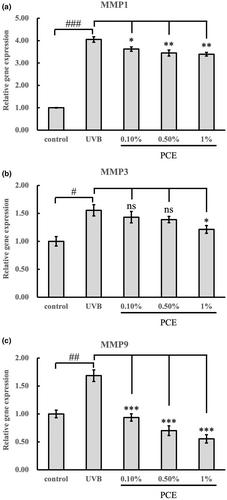Protective effects of Paeonia suffruticosa callus extract in skin through anti-inflammation and repair UVB-induced damage
Abstract
Objective
The study investigated effects of peony callus extracts (PCE) on the protective efficacy against Ultraviolet B (UVB)-induced photoageing, using in vitro and in vivo studies. The research focused on PCE's ability to protect against inflammatory factors, DNA damage and accumulation of senescent cells, along with the evaluation of the extract's potential anti-photoageing benefits to skin.
Methods
Human keratinocyte cell line (HaCaT cells), mast cells and fibroblasts were used to evaluate the role of PCE in anti-photoageing. The expression of genes of interleukin-1α (IL-1α), IL-6 and transient receptor potential vanilloid 1 (TRPV1) were tested in HaCaT cells. The histamine contents in mast cells were tested to evaluate the effect of PCE on soothing skin. Additionally, the repairment of PCE on DNA damage stimulated by UVB using comet assay was evaluated. In fibroblasts, the gene expression of matrix metalloproteinases (MMPs) and the activity of β-galactosidase were tested. In vivo test, 13 healthy volunteers were enrolled to apply a formula with 1% PCE to assess the variation in inner skin collagen contents.
Results
The callus from an ancient and rare variety of tree peony (Paeoniaceae family) was successfully induced, and its ingredients were extracted. The PCE could significantly downregulate inflammation factors such as IL-1α, IL-6 and TRPV1 in HaCaT cells, and MMPs in fibroblasts which could cause the collagen degradation induced by UVB. Meanwhile, UVB-induced DNA damage was alleviated by PCE. The analysis of histamine content in mast cells revealed that PCE effectively alleviated skin sensitivity. Furthermore, the clinical trials validated a significant increase in total collagen content in vivo, following 28 days of continuous application of a cosmetic formulation containing 1% PCE measured by Raman confocal spectroscopy technology.
Conclusion
The PCE could downregulate the gene expression of inflammatory factors, indicating the ability of DNA repair. The number of senescent cells was also decreased after UVB stimulation. Furthermore, the results of in vivo study showed that PCE was an ideal cosmetic ingredient for promoting collagen levels.


 求助内容:
求助内容: 应助结果提醒方式:
应助结果提醒方式:


